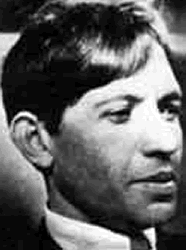Vilna
Stories
Click
on Photos to Enlarge
Chaïm
Soutine (1894-1944) was the 10th child of a Jewish family
Born 1893, Smilovitsji
Brought up in the strict observance of the Jewish orthodox religion, Soutine somewhat rebelled against his father, who was a tailor, and managed to attend the Academy of Fine Arts of Vilna at 14 before settling in Paris in 1911. There he was admitted at the Ecole des Beaux-Arts and worked under Fernand Cormon.
Living in one of the famous studios of la Ruche near Montparnasse. He then befriended Chagall and Modigliani and after a short trial period he came to find his own style mixing his Jewish feelings with the teachings of Fauvism and Cubism.
In fact, Soutine could never detach himself from the memories of the hardship suffered during his younger days. A kind of feverish passion drove him to produce distorted and violently coloured paintings and on reaching fame he said that if he had failed in his attempt to become a great artist he would probably have given up painting to become a boxer. Ill-tempered and unsociable, Soutine was kind only with women. Often facing depression he was once saved from suicide by his friend Krémègne.
After a period during which he was deeply affected by the death of Modigliani in 1920 he however worked intensely and managed to sell one hundred of his works to Dr Barnes, a well-known American collector. Investing himself in painting with a rage reminiscent of that shown previously by Van Gogh, he went on to produce landscapes, still lifes and portraits which were true masterpieces. Constantly obsessed by forms and colours, often dejected and unsatisfied, Soutine destroyed many paintings during fits of despair. He seldom showed his works, apart during the important exhibition of Independent Art held in 1937 in Paris where he was at last hailed as a great painter.
His glory was however short-lived since a few months after the invasion of France by German troops he had to flee the French capital and live like a fugitive in order to escape arrest by the hands of the Gestapo or the Vichy police. Humiliated and persecuted, he had to move from one place to another and was sometimes forced to seek shelter in forests, sleeping in open-air at night. Suffering from a stomach ulcer and bleeding badly he had to leave a safe hiding place in order to undergo urgent surgery.
After a perilous travel during which he was hidden in a hearse he died a few hours after a surgical operation in a Paris hospital on August 8th 1944 two weeks before the French capital was freed by Allied troops. Known as a major Expressionist painter, Soutine, so miserable during his lifetime, became a legend after his death. His works are worth between US $ 180,000 and 2,500,000.
http://www.artcult.com/soutine.htm
Born 1893, Smilovitsji
Brought up in the strict observance of the Jewish orthodox religion, Soutine somewhat rebelled against his father, who was a tailor, and managed to attend the Academy of Fine Arts of Vilna at 14 before settling in Paris in 1911. There he was admitted at the Ecole des Beaux-Arts and worked under Fernand Cormon.
Living in one of the famous studios of la Ruche near Montparnasse. He then befriended Chagall and Modigliani and after a short trial period he came to find his own style mixing his Jewish feelings with the teachings of Fauvism and Cubism.
In fact, Soutine could never detach himself from the memories of the hardship suffered during his younger days. A kind of feverish passion drove him to produce distorted and violently coloured paintings and on reaching fame he said that if he had failed in his attempt to become a great artist he would probably have given up painting to become a boxer. Ill-tempered and unsociable, Soutine was kind only with women. Often facing depression he was once saved from suicide by his friend Krémègne.
After a period during which he was deeply affected by the death of Modigliani in 1920 he however worked intensely and managed to sell one hundred of his works to Dr Barnes, a well-known American collector. Investing himself in painting with a rage reminiscent of that shown previously by Van Gogh, he went on to produce landscapes, still lifes and portraits which were true masterpieces. Constantly obsessed by forms and colours, often dejected and unsatisfied, Soutine destroyed many paintings during fits of despair. He seldom showed his works, apart during the important exhibition of Independent Art held in 1937 in Paris where he was at last hailed as a great painter.
His glory was however short-lived since a few months after the invasion of France by German troops he had to flee the French capital and live like a fugitive in order to escape arrest by the hands of the Gestapo or the Vichy police. Humiliated and persecuted, he had to move from one place to another and was sometimes forced to seek shelter in forests, sleeping in open-air at night. Suffering from a stomach ulcer and bleeding badly he had to leave a safe hiding place in order to undergo urgent surgery.
After a perilous travel during which he was hidden in a hearse he died a few hours after a surgical operation in a Paris hospital on August 8th 1944 two weeks before the French capital was freed by Allied troops. Known as a major Expressionist painter, Soutine, so miserable during his lifetime, became a legend after his death. His works are worth between US $ 180,000 and 2,500,000.
http://www.artcult.com/soutine.htm
